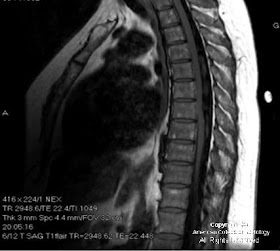


Findings
These MR images demonstrate focal anterior displacement of the spinal in the mid thoracic spine. The cord (Images 1,2 and 3) appears to be either tethered anteriorly or compressed from the posterior aspect. The intradural space behind the cord is widened and has signal characteristics identical to CSF (Images 1,2 and 3).
Diagnosis: Idiopathic Thoracic Cord Herniation
Spinal cord herniation occurs when the cord herniates through a defect in the dura mater. These dural defects are typically located anteriorly or laterally, and occur most often in the mid-thoracic region. They may be idiopathic, post-traumatic or iatrogenic related to prior spinal surgery. Some have suggested that a herniated and calcified disk may cause thinning, erosion, or rupture of the dura, which may also be secondary to congenital weakening of the ventral dural fibers. The presence of free flow of cerebral spinal fluid dorsal to the herniated cord is key to differentiating a spinal cord herniation from an arachnoid cyst. Spinal cord herniation occurs most commonly in the middle-aged. Symptoms of myelopathy including chronic leg pain, gait disturbance, incontinence, and leg weakness are commonly seen and may slowly worsen over time if left untreated. The most common clinical feature reported is the Brown-Séquard syndrome consisting of hemiplegia and contralateral temperature sensation deficits and pain.
Typical imaging findings are focal anterior displacement of the spinal cord with expansion of the dorsal subarachnoid space. The preferred imaging modality in the setting of myelopathy is MRI, which is often sufficient for making the correct diagnosis. Myelography with CT may be required in ambiguous cases and to demonstrate the exact location of the dural defect. With cord herniation, myelography reveals uninterrupted flow of contrast and the absence of a filling defect posterior to the herniated cord segment. An arachnoid cyst will present during myelography as an early filling defect posterior to the displaced cord. Contrast may fill the cyst with time, so rapid acquisition of CT-myelograpgy after the initial myelographic images is essential. Phase contrast cine MR imaging may provide similar CSF flow information, in addition to restricted cord motion.
Treatment consists of surgically reducing the herniation by repositioning the protruding spinal cord back into the thecal sac followed by the repair of the defect in the dural mater in order to prevent recurring herniation. After surgery, symptoms typically improve and may completely resolve, even when longstanding. Patients whose symptoms are milder and non-progressive may be eligible for less invasive therapy or conservative management with monitoring.
Nessun commento:
Posta un commento